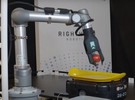‘Soft’ robots are made of malleabl e materials such as silicone and other polymers instead metal. These materials give robots organic characteristics, replicating the way muscles work and allowing robots to move and perform human-like tasks that are impossible for old-school metallic machines.
e materials such as silicone and other polymers instead metal. These materials give robots organic characteristics, replicating the way muscles work and allowing robots to move and perform human-like tasks that are impossible for old-school metallic machines.
Engineer and Scientist Tim Chin explains why he thinks soft robotics and agriculture go hand in hand “A specific application of soft robotics that interested me is agriculture.,” he explains. “Most automatic solutions for harvesting only operate on large sturdy crops. There are a few mechanisms for collecting smaller crops, but many are violent and tend to damage the plant in the process. There have been advances by companies such as Soft Robotics Inc, that incorporate soft elements into their robotic grippers. These grippers still depend on the object of interest to have some sturdiness.”
“Such predicaments led to a research project I participated in. The projects goal was to explore the autonomous picking of light fragile berries, specifically raspberries,” he continued. ” A unique gripper was desired for that task. Considering the fragility of raspberries, this was an opportune problem to solve with soft robotics.”
The usefulness of a robot that can carry boxes around a warehouse and self-repair if it’s damaged is clear. It is not obvious what the use case for a robot with feelings would be, even if many human inventions did not come from a utilitarian drive. There are also ethical challenges, not to mention the possibility of humanity being taken over by machines.
Source: agritechfuture.com
